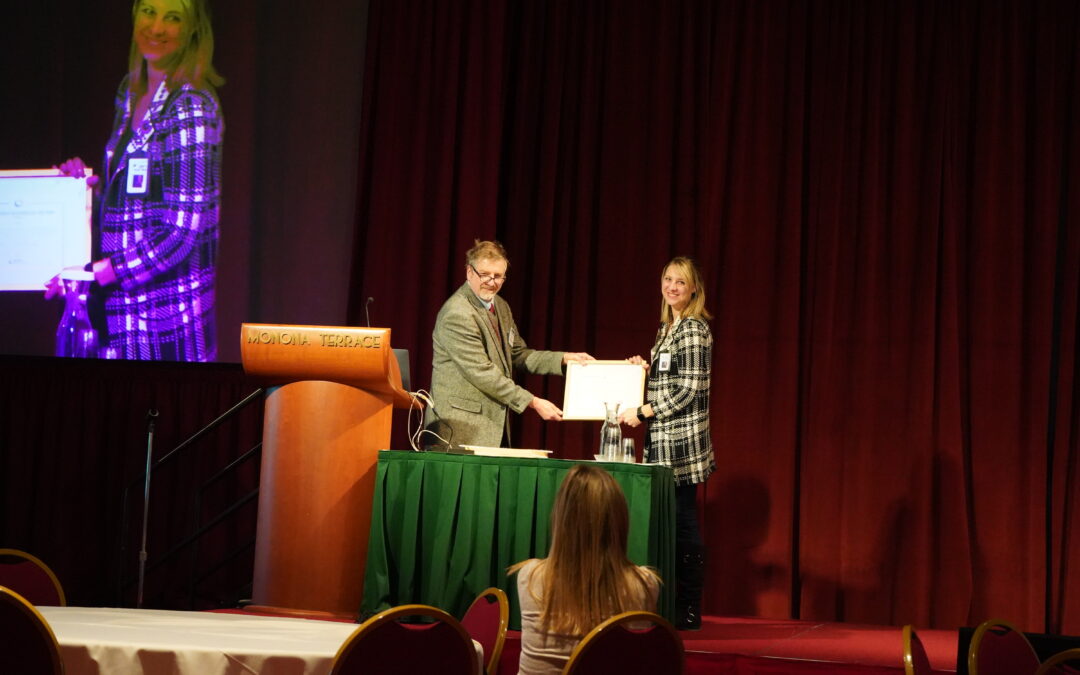
by RENEW Wisconsin | Jan 31, 2022 | Policy, Press Release, Solar, Utilities
During its eleventh annual Renewable Energy Summit, titled “All Roads Lead to Clean Energy,” RENEW Wisconsin honored individuals and businesses who have made significant and lasting advances in clean energy development here in Wisconsin. Presented by greenpenny, Invenergy, and NextEra Energy Resources, the summit took place Thursday, January 27, 2022, at Monona Terrace in Madison. Due to the ongoing coronavirus pandemic, this year’s Summit featured a mix of in-person and online attendees and speakers.
In keeping with the program theme, summit presenters spotlighted the intertwining pathways leading Wisconsin closer to the zero-carbon goals embraced by state and local leaders, influential businesses, schools, and nonprofit organizations. Featured speakers included Commissioner Tyler Huebner (Wisconsin Public Service Commission) and Kari Lydersen (author and journalist).
During the summit, RENEW presented awards to a trio of clean energy businesses and champions in recognition of the leadership they’ve demonstrated in the years leading up to the present occasion. They are:
2022 Awardees
Clean Energy Business of the Year: Arch Solar, Plymouth
Arch Solar, a Plymouth-based company, founded in 2003, has become the largest full-service solar contractor in Wisconsin, with about 90 employees. Arch connects veterans to solar energy, primarily through its efforts to place them in its workforce. It is also a certified Women’s Business Enterprise, one of the few in the clean energy field.
Clean Energy Educator of the Year: Kenneth Walz, Madison Area Technical College
Kenneth Walz is a nationally recognized leader in developing coursework and training materials to help post-secondary students acquire skills for entry into the renewable energy workforce. As director for the Center for Renewable Energy Advanced Technological Education, Ken has enabled Madison Area Technical College to become the state’s preeminent energy education center and laboratory. Ken has also been an effective internal champion for “solarizing” all Madison College’s campuses. With the recent installation of a 133-kilowatt array at its Watertown branch, the Madison College system now hosts more solar generating capacity than any other school or local government in Wisconsin. In 2020, U.S. EPA bestowed a Green Power Leadership Award to Madison College for incorporating clean energy into its curriculum and operations.
Clean Energy Trailblazer of the Year: Susan Millar, 350 Madison
Susan Millar is a member of 350 Madison, a local citizens group catalyzing meaningful public and private actions to address climate change threats. She recently launched an ambitious effort to re-engineer her 90-year-old house to become an all-electric residence. Susan converted her conventionally heated house to one that runs on an all-electric, solar-assisted energy platform. She disengaged from a convenient but carbon-intensive heating source to rely on electric heating appliances and technologies instead. Susan’s house has been gas-free since September 2021.
This year’s Summit program also drew attention to other milestones and notable achievements in 2021, including the following:
- The Public Service Commission (PSC) approved six large solar projects—Wood County, Grant County, Onion River, Darien, Springfield, and Apple River—that will add 950 megawatts (MW) of solar power to Wisconsin’s electric generation portfolio.
- The PSC also approved applications from Alliant-Wisconsin Power and Light and Xcel-Northern States Power of Wisconsin to add a combined seven solar farms totaling 764 MW to their respective power plant fleets.
- Madison Gas and Electric completed its largest Renewable Energy Rider project to date. Located in Fitchburg, the 20 MW O’Brien Solar Fields project serves seven customers, including the State of Wisconsin and the University of Wisconsin-Madison.
- In partnership with the Couillard Solar Foundation, RENEW’s Solar for Good program issued grants for leveraging the installation of 1.27 MW of solar capacity serving 26 nonprofit-owned entities across the state.
- The first combined solar and microgrid project, serving the Bad River Tribal reservation in Ashland County, was placed in service. Project partners included a local nonprofit, Cheq Bay Renewables, and Menasha-based EnTech Solutions, the contractor that designed the project for the tribe.
- Employing the group purchase model, solar contractors teamed up with nonprofits and local governments to install 1,887 kW of solar capacity to 260 residential customers across the state.
This annual event featured an exposition hall, breakout sessions, and industry professionals discussing the current and future opportunities for advancing renewable energy in Wisconsin.
Click here for more information on the 2022 Summit program agenda, speakers, and registration.
This year’s Summit was supported by over 100 sponsors including greenpenny, Invenergy, NextEra Energy Resources, Alliant Energy, Arch Electric, ATC, Couillard Solar Foundation, Eagle Point Solar, OEI (Wisconsin Office of Energy Innovation), Savion, Stantec, Boldt, CED Greentech, EDF Renewables / Distributed Solutions, Foley & Lardner LLP, Generac, Michael, Best and Freiderich, MREA, Northwind Solar, OneEnergy, REC Group, SC Johnson, Steigerwaldt Land Services, SunPeak, Focus on Energy, AVID Risk Solutions, Carlson Electric, Braun Intertec, Current Electric, Dane County Office of Energy and Climate Change (OECC), Endries Solar and Electric, Entech Solutions Inc, Full Spectrum Solar, Glow Solar, Good Steward Consulting, HellermannTyton, Ingeteam, JCG Land Services Inc, WI K-12 Energy Education Program, Keyes & Fox, Madison College, Milwaukee Shines, muGrid Analytics, National Grid, Nautilus Solar, Pines Bach, PRC Wind, Ranger Power, Ruekert- Mielke, Stone House Development, SunBadger Solar, TRC, Werner Electric, WIDRC, Xcel Energy, Ayres Associates, Chint Power Systems (CPS), Michael J. Allen, EOR, Kapur & Associates, Legacy Solar Cooperative, McKinstry, Midwest Solar Power, Northeast Wisconsin Technical College, Oconomowoc Realty, Organic Valley, PACE, Sustain Dane, Trillium Construction, Vanguard Real Estate Solutions, Westphal & Company, Inc., Wisconsin Clean Cities, Wisconsin Conservative Energy Forum, All Energy Solar, Audubon Great Lakes, Aurora Solar, City of Madison, Clean Fuel Connects, Clean Wisconsin, Construction Business Group (CBG), Convergence Energy, Eland Electric, EMCS, Energy Analysis and Policy – Nelson Institute for Environmental Studies, Energy News Network / Midwest Energy News, Ethos Renewable Energy, Equix, Inc, GDS Associates, Gundersen Health System, HGA Architects and Engineers, JDR Engineering, Local 139 Operators, North Central States Regional Carpenters Council, Nokomis Energy, Samsung Renewable Energy, Solar Connection, Summit Ridge Energy, UA Local 400 Plumbers & Pipefitters, UW Office of Sustainability, WES Renewables (Engineering), Westwood, Wisconsin Academy of Sciences, Arts and Letters, Wisconsin Energy Institute, Wisconsin Health Professionals for Climate Action, WI Sustainable Business Council, and WPPI Energy.
About RENEW Wisconsin
RENEW Wisconsin is a nonprofit organization that promotes renewable energy in Wisconsin. We work on policies and programs supporting solar, wind, biogas, local hydropower, geothermal energy, and electric vehicles. More information can be found on RENEW’s website: www.renewwisconsin.org.
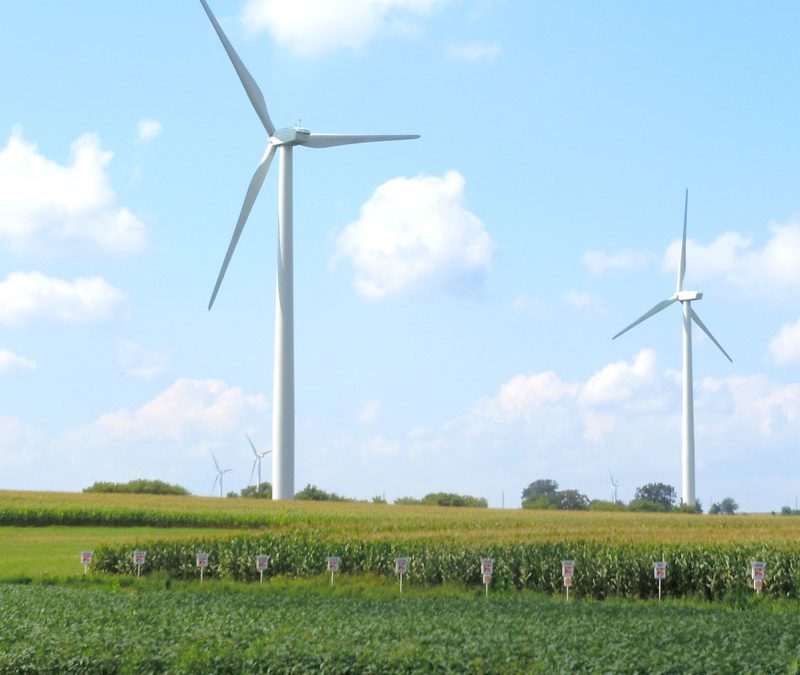
by Michael Vickerman | Jan 7, 2022 | Policy, Utilities, Utility Scale, Wind
A 28-turbine wind power project in Grant County will soon become a utility-owned source of clean electricity, thanks to a Public Service Commission of Wisconsin (PSCW) approval.
With this approval in hand, construction of the Red Barn Wind Energy Center should commence this spring and proceed quickly to completion before the year’s end. Once Red Barn’s 28 turbines begin generating power, Green Bay-based Wisconsin Public Service Corporation (WPS) and Madison Gas and Electric (MGE) will assume ownership of the project. WPS’s project share will be 90%, while MGE will own the remaining 10%.
With a generating capacity of 91.6 megawatts (MW), Red Barn is expected to produce approximately 300,000 megawatt-hours annually. That quantity of clean electricity will rival the annual output from Badger Hollow 1, a 150 MW solar farm located 10 miles east in neighboring Iowa County. WPS and MGE also co-own Badger Hollow 1, which began operating in December 2021.
“The evidence presented by both utilities and project supporters was powerful and unambiguous. Red Barn will be an economically attractive source of zero-fuel cost, zero-emission electricity that will produce savings for Wisconsin ratepayers and reduce power plant emissions, including greenhouse gases for years to come,” said RENEW Wisconsin Policy Director Michael Vickerman.
Red Barn’s original developer, Minnesota-based Project Resources Corporation (PRC), secured a conditional use permit from Grant County in July 2019. The siting permit granted to Red Barn was the first issued by a local government in this state since the Wind Siting Rule (PSC 128) took effect in 2012.
PRC subsequently sold the rights to develop Red Barn to ALLETE Clean Energy, another Minnesota-based energy company, which will build the wind farm before transferring it to WPS and MGE for an estimated $162 million.
Vickerman added: “RENEW commends Project Resources Corporation for blazing the trail here, working with willing landowners as well as accommodating neighbors and local officials to assemble and shepherd a wind power project from conception to siting approval, sparking no discernible opposition in the process.”
Red Barn will also be the first Wisconsin-based wind energy power plant to be added to the generation portfolio of any Wisconsin investor-owned utility since We Energies’ 162 MW Glacier Hills project started producing power in late 2011. Since then, only one utility-scale wind farm, the 99 MW Quilt Block project in Lafayette County, has come online. Quilt Block has been generating power for sale to Dairyland Power Cooperative since 2017.
Throughout Red Barn’s operating life, Grant County and the Towns of Wingville and Clifton will receive a combined $368,000 in utility local aids each year.
In 2020, wind projects located in Wisconsin accounted for 2.4% of the state’s electricity supply, according to the PSCW.
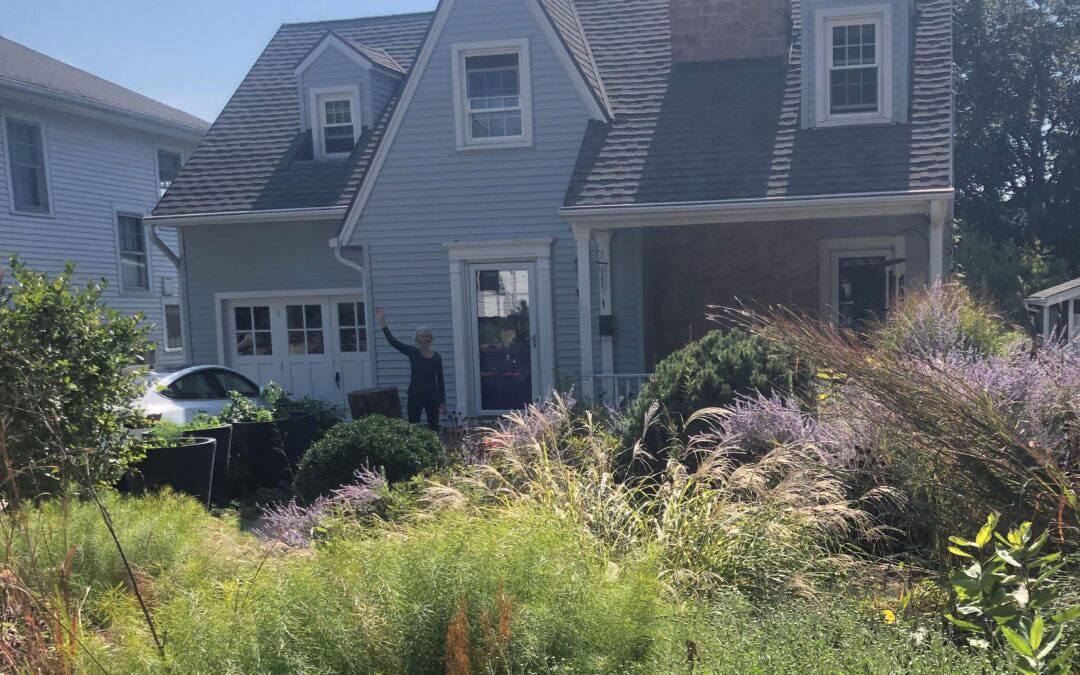
by Guest Blog | Nov 24, 2021 | Community, Focus on Energy, Home, Renewables, Solar, Sustainability
Beneficial electrification discussions often revolve around transportation electrification, specifically how electrifying vehicles can reduce emissions and offer cost savings for consumers. However, an under-discussed and equally important part of beneficial electrification is the building sector. At 24% direct emissions, the building sector comprises the largest end-use emissions in Wisconsin. Read further to learn about Susan Millar’s journey towards electrifying her home, including her installation of an air-source heat pump for greater heating and cooling energy efficiency.
The companies, technologies, and programs endorsed in this blog are not necessarily recommended or endorsed by RENEW Wisconsin. The following information and personal experience is illustrative of the process to electrify a residential property in Wisconsin.
Are you wondering how to convert an older single-family home with a forced hot-air heating system, a gas water heater, and a gas stovetop from gas and electric to electric-only? I have done that with a 90-year old house on the near west side of Madison. And because it took a fair amount of time, I am sharing the process I used. Before describing this process, I provide important context.
Context for Transitioning to All-Electric
- “Natural” gas is fossil gas. It must, and will, be phased out over time as our society gets more serious about reducing climate-warming emissions. In some municipalities, bans on gas in new construction are already in place.
- Air source heat pumps (ASHPs) are the energy-efficient electric-powered alternative to gas heating systems. ASHPs both heat and cool your house (no separate AC device needed). They have a high coefficient of performance, so while they use electricity, the amount is much less than, say, what an electric space heater or traditional AC unit uses. See, for example, this video description of ASHPs.
- Air source water heaters (also called “hybrid” water heaters) work the same way as ASHPs except they exchange air with your basement instead of the air outside. They are far more efficient than traditional electric water heaters.
- Our state’s Focus on Energy program provides rebates for air-source air and water handling systems. The installers handle this process. (I am not sure of the size of these rebates.)
- MG&E’s monthly (gas) service charge is $22. If you stop your gas service and start it again, they will bill you for monthly service charges for up to 12 months prior to the time you start again. That is, you cannot stop your gas service except for, say, the month of January without paying for up to 12 months of service.
- If you have not yet, or cannot install, solar panels on your roof, you can sign up for MGE’s shared solar program.
- If you have an EV and are willing to charge it and also run your dishwasher, etc during MG&E’s low-rate (off-peak) period (from 9 pm to 10 am on weekdays, and during weekends and holidays), you can substantially reduce your electricity bill. To do this, call MG&E and ask them to add you to their ‘Time Of Use’ program.
- Yes, you have to lay out money ahead of time to transition from gas, and I am aware that many people cannot do this. The financial payoff comes over time. For example, while paying both gas and electric service charges, and charging my EV at home, my MG&E bill this summer was between $20 -30 per month. This is largely due to having rooftop solar and Time Of Use electricity rates. While my utility bills will be higher this winter, they will be reduced by the $22 monthly gas service charge and will be substantially less than prior winters. For me, another major advantage is that I am emitting essentially no carbon dioxide to run my home and car.
Steps for Transitioning to All-Electric (used by an early adopter)
- Get an energy efficiency analysis. This is very important because if you switch from a furnace powered by an unlimited amount of gas to an ASHP, it’s important that your house holds its temperature (in winter or summer) as effectively as possible. I used a local energy efficiency consultant. He did a superb job.
- Improve your insulation. If your energy efficiency analysis indicates that your house needs insulation, then arrange to get it. I used a small local company that treated my home as if it was their own. I felt the difference immediately, even in summer.
- Replace your gas stovetop (both to get off of gas and because much new research indicates respiratory health problems are caused by gas stovetops). As I have a unit with an electric oven and gas stove, I purchased two Cuisinart’s Double Induction Cooktops (not expensive), which I placed over the gas burner area on my stove and just plugged in. (Induction stovetops work great, and are much easier to keep clean.)
- While doing steps 1 & 2, get contracts with the HVAC and plumbing company you will use. I started with the local HVAC company that I was used to. They proposed an ASHP system that would heat my house to +14F degrees and required that I retain my gas furnace for backup in the winter. As I want to eliminate the year-round monthly gas service charge, I turned them down. I tried 3 other local companies. Same response. I looked wider and found a company located near Milwaukee. In light of the energy efficiency and size of my house, they proposed to replace my gas furnace and AC units with a Mitsubishi P system that will efficiently heat my house to -14F, and then shift to an electric element (low efficiency) backup system for super cold snaps. Their price? Same as the local HVAC folks who proposed installing a +14F system with gas back-up. I accepted Midwest’s proposal. Moreover, they agreed to install my (still effective and efficient) gas and AC units in the home of a friend who has very inefficient HVAC systems – so the embedded carbon in those devices is not immediately trashed. (FYI, I informed the local HVAC companies of my decision – they lost my business to a more cutting-edge, non-local competitor.)
- Meanwhile, after checking different local plumbers, most of whom do not install hybrid water heaters, I found a small local plumbing company that proposed to install one of these at a very decent price. I happily accepted his bid.
- Both the HVAC and plumbing companies I signed with encountered installation delays because ASAP and hybrid water heater manufacturers are having sourcing issues. These problems are either due to Covid shipping issues or because the manufacturers are sending their stock to states that are ahead of us on installing these systems. Demand pushes the market.
- Both the hybrid water heater and the ASHP have easy controls and work superbly. For the mid-October to mid-November billing period, the first during which I used electricity to heat water, heat the house, and charge my EV, I used 664 kWh. My MG&E bill was $54. In round numbers, they charged me $42 for connection and distribution services, $15 for contributions to their Shared Solar, Green Power, and Low-Income Assistance programs, and $37 for electricity used at variable rates. (I have “Time of Use.” Most of my use was at the very lowest rate.) They credited me $39 for “net energy exported at variable rates” (kWhs from my solar panels), and $2 for “fuel cost.” All that suggests that I paid $-2 for electricity provided by MG&E.
- If you would like cost or contact information for the energy efficiency, insulation, HVAC, plumbing, and electrician contractors I used, just email me at sbmillar@gmail.com.
Susan Millar, September 2021

by Andrew Kell | Nov 10, 2021 | Advocacy, Community, Focus on Energy, Local Government, Policy, PSC Priorities, Public Service Commission
In 2019, Governor Evers issued Executive Order #38 to establish a goal for carbon-free electricity in Wisconsin by 2050. As the state regulator of utilities, the Public Service Commission (PSC) is tasked with regulating the number one sector source for greenhouse gas emissions in Wisconsin[1]. As a result, PSC decisions play a key role in determining whether Wisconsin will be able to achieve a zero-carbon grid by 2050.
The PSC reviews utility proposals for construction projects, rate increases, and new utility programs for their customers. However, the PSC reviews these proposals separately from one another, and historically without the integration of other utility plans, carbon reduction goals, and cross-sector emission-reduction strategies. The good news is that the PSC has begun to explore how to incorporate these factors within its decision-making processes going forward.
In keeping with a recent trend of investigating policy issues (such as Electric Vehicles and Parallel Generation), this past spring the PSC opened a docket (5-EI-158) to pursue a “Roadmap to Zero Carbon.” As described in the Notice of Investigation, the PSC intends to evaluate government and utility goals to reduce carbon emissions to zero by 2050, recommendations from recent Wisconsin reports on clean energy and climate change, and the development of partnerships to achieve carbon-free electricity by 2050.
The Zero Carbon Roadmap docket garnered much interest from active PSC intervenors (such as RENEW), with participation from environmental, health, and business advocates as well. Members of the general public also participated with input and suggestions. PSC staff issued a memo for public comment on scoping of priorities. After gathering public input, PSC staff issued a follow-up memo to the Commissioners in August that summarized stakeholder input and provided the Commissioners with options on the next steps. The Commissioners then discussed the memo and issued an order in September to take some initial actions.
In short, the PSC decided to leverage ongoing planning processes and to investigate a potentially new approach to utility ratemaking. Below is a summary of these initial steps:
- The PSC will gather more robust carbon-reduction planning information from utilities during the current biennial Strategic Energy Assessment (SEA). Utilities will soon respond to the PSC staff’s initial data request, and PSC staff will issue a draft report by next spring for public comment;
- Additionally, the PSC will seek public input on ways in which the state’s Focus on Energy program (Focus) can better incorporate beneficial electrification, programs for low-income customers, demand response, and other utility voluntary programs into its program design over the next four years. This is called the Quadrennial Planning Process, and a PSC staff recently issued a memo for comment on scope; and
- Finally, the PSC will organize a workshop on Performance-based Regulation (PBR). This workshop will gather information and perspectives on how rethinking utility goals and investment incentives can lead to a more equitable clean-energy future. The PSC will also consider customer affordability issues in relation to the transition to a zero-carbon grid.
Even with these planning processes already underway, the book is not closed on the Roadmap to Zero Carbon docket. RENEW recently reached out to Joe Fontaine, PSC Policy Advisor, to get a better sense of next steps for the investigation docket itself. Fontaine said:
“Commission staff is excited to kick off the Roadmap by addressing four of the highest priorities identified by commenters and approved by the Commission. Each of these four areas — more transparent resource planning, development of performance-based regulation concepts, and further analysis of affordability and energy efficiency issues — can help us develop a strong general foundation to address a wider range of issues related to the clean energy transition, in this investigation as well as in other Commission dockets. Future decisions in the Roadmap will be well-informed by the analysis and stakeholder input we’re receiving at each step in the investigation. Potential next steps will be determined as we make progress on these initial priorities over the next few months.”
The PSC’s Roadmap to Zero Carbon activities is running in parallel with the Office of Sustainability and Clean Energy’s (OSCE) Clean Energy Plan drafting process. Beyond the electricity sector, the Clean Energy Plan will assess, and make recommendations on, strategies cutting across all economic sectors statewide. The OSCE recently gathered public input during several public listening sessions, focusing on 1) economic and environmental justice, 2) infrastructure and industry, 3) transit and transportation, and 4) clean energy and energy efficiency. The OSCE continues to gather written comments through its website.
RENEW is also proactively partnering with Clean Wisconsin and GridLab to conduct a zero-carbon grid study for the PSC’s consideration. While the scope is still being finalized, the study will use modeling designed to answer important policy questions, such as:
- What is the right mix of renewable resources in-state and out-of-state?
- What is a good balance between utility-scale and distributed solar resources?
- How much transmission is needed in a zero-carbon future?
- What will be the health, jobs, and economic impacts as we make this clean grid transition?
Stay tuned on these zero-carbon planning activities and upcoming study developments. RENEW plans to organize presentations and panel discussions on these topics at our Renewable Energy Summit on January 27, 2022.
[1] See the Department of Natural Resources’ Wisconsin Greenhouse Gas Emissions Inventory Report of August 2020. Figure 1, on page 3, presents emissions by sector. Electricity generation is the highest emitting sector and represents 33 percent of all Wisconsin emissions.
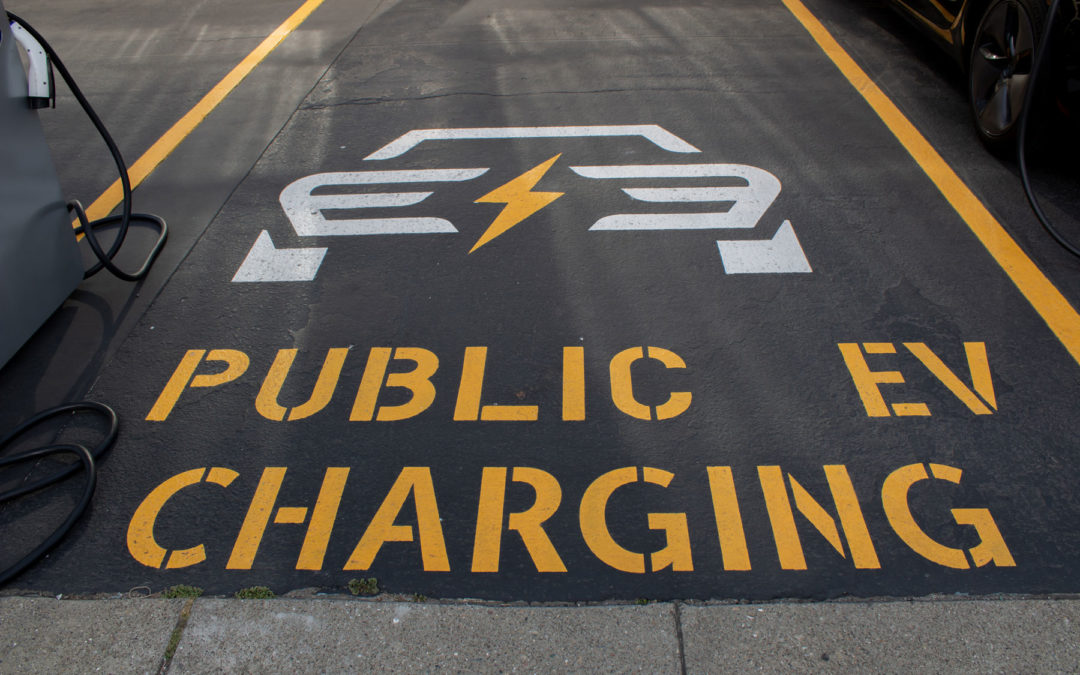
by Jeremy Orr | Nov 9, 2021 | Electric Vehicles, Legislative Watchlist
On Friday, the House of Representatives passed the $1.2T Infrastructure Investment and Jobs Act – better known as the Federal Infrastructure Package – which will provide billions of dollars for electric vehicles, including:
- $7.5B for a national electric vehicle (EV) charging network
- $2.5B for zero-emission-only school buses
- $2.5B for zero-emission and low-emission school buses
- $6.1B domestic battery manufacturing and recycling, and
- $65B for electric grid upgrades (to support renewable energy development)
Although this list is not comprehensive of everything included in the Bill, Wisconsin can expect to receive $79M over five years to develop an electric vehicle charging network and be eligible to apply for the $2.5B in grant funding dedicated to electric vehicle charging stations.
Considering that a lack of public charging has been the primary barrier to electric vehicle adoption in the U.S. – especially in Wisconsin – the influx of funds for charging stations will likely result in a boon to the EV market.
Looking forward, to avoid stranded assets and ensure the likelihood of use, Wisconsin should consider a strategic deployment of public charging stations. Planning should include modeling that views EV penetration rates and market data, the volume of traffic data, potential station costs per site, and other relevant information, similar to Michigan’s method for developing its Charge Up Michigan program. Doing so will minimize total investment costs of stations – especially for site hosts and other stakeholders – ensure the feasibility of intercity and intracity electric vehicle trips, and contribute to better grid management.
And speaking of investment, don’t forget that Wisconsin’s slated $79M in funding for electric vehicle charging stations could result in a five-fold return on investment, in addition to a $2.60 private investment for every $1 of public dollars spent on transportation electrification measures. In other words, the $79M investment could result in a five-fold return of $395M, with an additional $205,400,000 in private investments. These numbers don’t include the economic benefits of potential jobs created in a vastly expanding transportation electrification sector. Wisconsin may also receive federal monies from domestic battery manufacturing, zero-emission vehicles, the Build Back Better Act, or other federal and state clean energy programs.
This bill is a huge win for Wisconsin, and it will go a long way to advance our clean energy transition. Wisconsin will get the most “bang for its buck” if we are purposeful and precise in our planning.
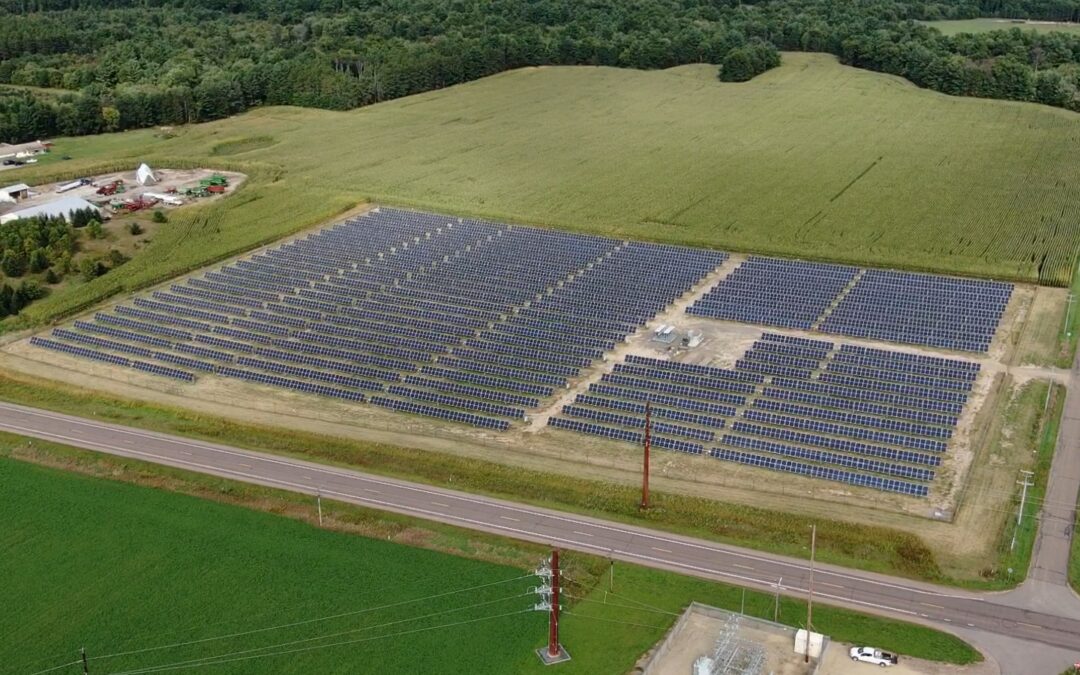
by Michael Vickerman | Oct 27, 2021 | Advocacy, Community, Community Solar, Local Government, Policy, RENEW Wisconsin, Renewables, Solar, Sustainability
For decades, utility investments in power plants and transmission lines have been predicated on the concept of economies of scale. The theory behind it is beguilingly simple: the larger the installation sought by an electric utility, the lower the unit cost of the investment, which utility planners and regulators regard as a measure of economic efficiency. When loads are growing, the “bigger is better” paradigm is often an economically rational fit for electric utilities seeking to recover large-scale capital investments in fossil generation over the broadest possible cohort of current and future customers.
But solar power, the default resource option for electric providers today, is a somewhat different animal due to its scalability. Yes, economies of scale can certainly reduce the unit price of solar generating capacity, but other on-the-ground factors can influence the economics of this resource. These factors include but are not limited to the cost of acquiring site control of the host properties and obtaining all the necessary approvals to construct the project. Interconnection costs can be high as well, especially for larger projects requiring additional land and approvals to supply power to the grid.
These thoughts came to mind after visiting two smaller solar farms that started producing power this year. The first project, called Strobus Solar, was developed by OneEnergy Renewables and serves Jackson Electric Cooperative. The second installation, O’Brien Solar Fields, was one of the stops in this September’s Ride with RENEW bicycle tour. Developed by EDF Renewables and owned by Madison Gas and Electric (MGE), this 20 MW solar farm in Fitchburg supplies electricity to seven MGE customers under long-term contracts.
At a Glance
Solar For the Distribution Grid – 2021 |
| Project name |
Strobus Solar |
O’Brien Solar |
| County of location |
Jackson |
Dane |
| Capacity (in MWac) |
1.5 |
20 |
| Project developer |
OneEnergy Renewables |
EDF Renewables |
| Project owner |
Greenbacker Capital |
Madison Gas + Electric |
| Utility territory |
Jackson Electric |
Madison Gas + Electric |
| General contractor |
Arch Electric |
Boldt Construction |
| Landowner |
Northern Family Farms |
O’Brien Brothers Farm |
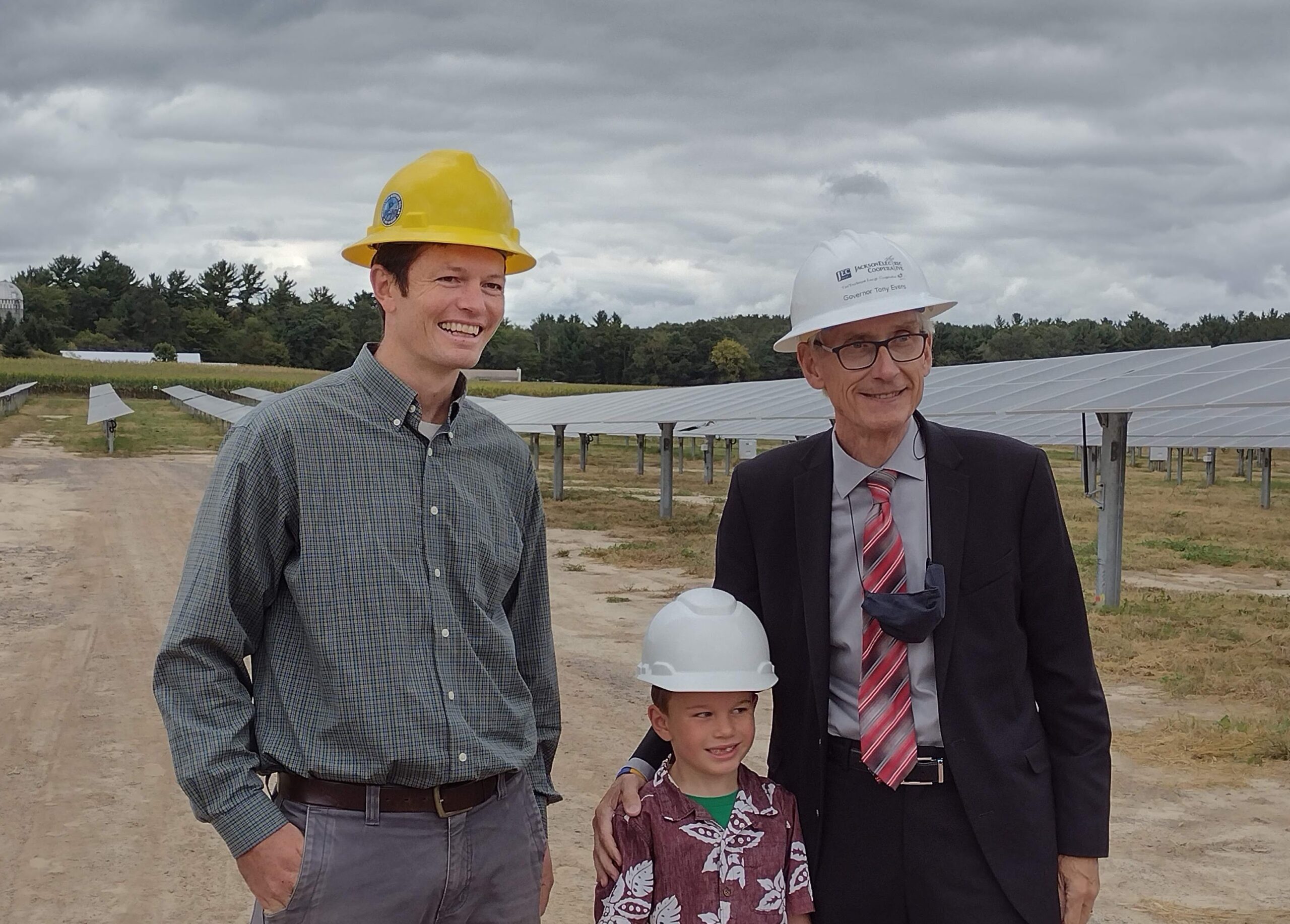 Governor Evers and the Project Developer, Eric Udelhofen, from OneEnergy Renewables at the Ribbon Cutting Ceremony for the Strobus Solar project.
Governor Evers and the Project Developer, Eric Udelhofen, from OneEnergy Renewables at the Ribbon Cutting Ceremony for the Strobus Solar project.
Strobus – A Mastodon Solar project
Occupying a mere 12 acres, Strobus Solar is located about six miles north of Black River Falls and is tucked into a compact parcel framed by evergreen trees and U.S. Highway 12. On a cloudy September day, more than 50 people attended a ribbon-cutting ceremony for the Strobus project, one of eight solar farms in southeast Minnesota and west-central Wisconsin that make up OneEnergy’s Mastodon Solar portfolio. With a combined 17 megawatts (MW) of AC-rated capacity, all eight Mastodon solar farms are located in the territory served by rural electric cooperatives.
As noted on OneEnergy’s website, “the electricity generated by each project will be purchased by the local participating electric cooperative, resulting in savings on energy supply and increased resiliency. These savings will be passed onto the cooperative’s members. The available Renewable Energy Credits will then be sold separately to visionary buyers committed to ensuring their renewable energy procurement dollars are devoted to new projects that serve local communities.”
Of the four Mastodon projects located in Wisconsin, Strobus is the second to be energized this year, following Blue Prairie, a 2.5 MW installation southwest of Black River Falls. The other two, Stromland and Shamrock, should be operating before the end of this year. Plymouth-based Arch Electric is the general contractor for all four Wisconsin projects.
Governor Evers spoke at the ribbon-cutting ceremony, along with representatives of Jackson Electric Cooperative, Arch Electric, and Northern Family Farms, the participating landowner. Based in nearby Merillan, Northern is Wisconsin’s largest Christmas tree grower, operating on more than 7,000 acres. After the prepared remarks, OneEnergy and Arch opened the gates to let Governor Evers and other guests circulate through the project and ask questions.
On one corner of the Strobus parcel is the substation that feeds the solar-generated electricity directly into the wires overhead. Though the equipment onsite is brand-new, low-growing grassy vegetation has already been established, covering the entire project footprint. After three years, the mix of deep-rooted, primarily native plants will provide a healthy habitat for birds, insects, and other species. At nearby Blue Prairie, sheep are already grazing around and under the 7,000 panels installed there.
Strobus is expected to generate about 3,000 megawatt-hours of electricity a year. But the Renewable Energy Credits associated with that output will not flow to Jackson Electric. They will instead be sold to Native, a Public Benefits Corporation, through its New Renewables Portfolio.
According to Native’s website, the purpose of the Portfolio “is to enable Renewable Energy Credit (REC) buyers to play a causal role in actualizing new renewable energy projects. Native has committed to a 10-year renewables purchase agreement with Strobus, LLC on behalf of Portfolio investors. Without this type of long-term REC purchasing agreement, this project would not be economically viable.”
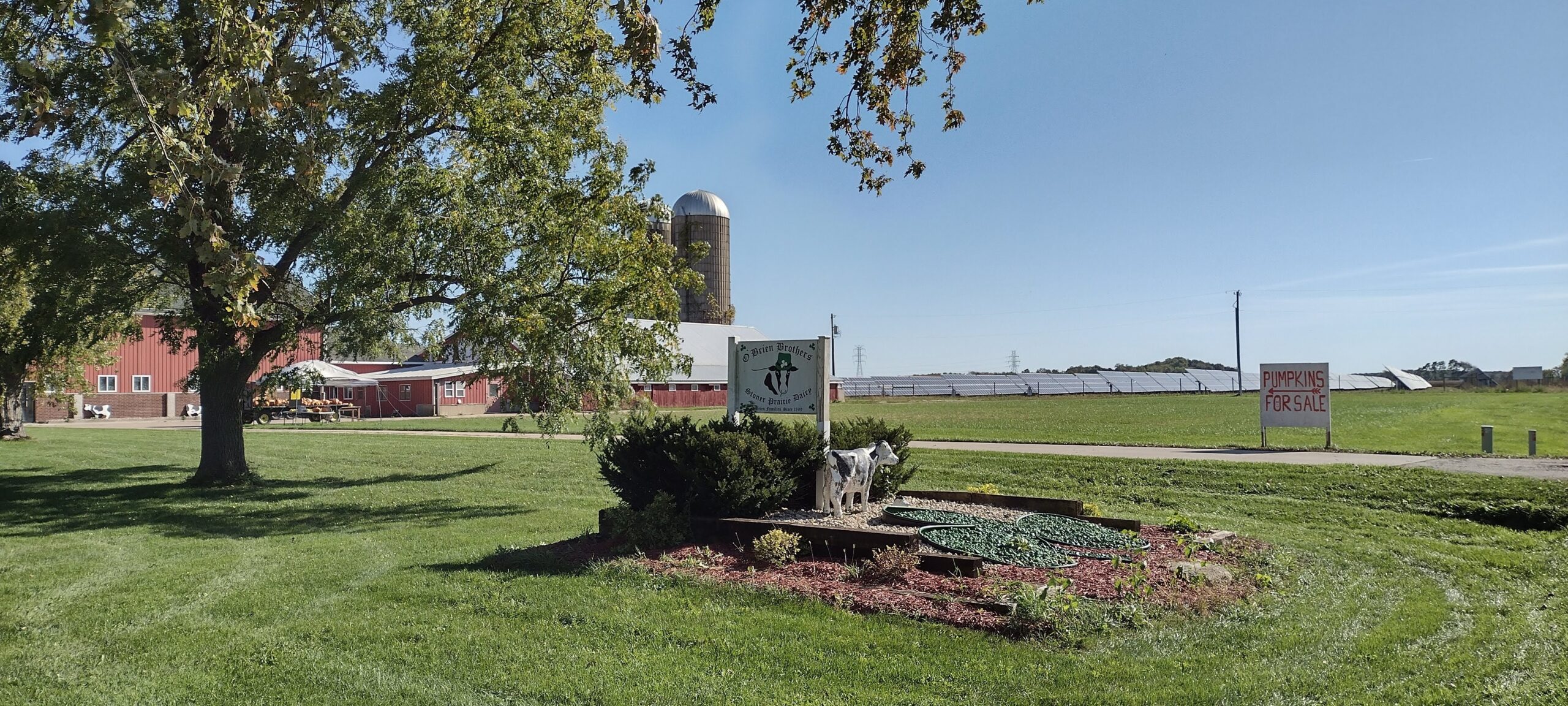 O’Brien Solar Fields in the city of Fitchburg, Wisconsin.
O’Brien Solar Fields in the city of Fitchburg, Wisconsin.
O’Brien Solar – Clean Energy Produced Offsite for Larger Customers
Occupying 130 acres along the edge of urban Fitchburg, O’Brien Solar Fields is as large as a distributed solar project gets. However, while every kilowatt-hour produced at O’Brien flows directly into Madison Gas and Electric’s distribution grid, only seven customers see the impact of this project on their utility bills. Those customers are the State of Wisconsin, University of Wisconsin-Madison, City of Fitchburg, Promega, Placon, Tribe 9 Foods, and Willy St. Co-op.
Energized this summer, O’Brien Solar is the newest Renewable Energy Rider (RER) project serving MGE customers. Several years ago, MGE received approval from the Public Service Commission (PSC) to build solar farms to serve individual customers, including those with multiple facilities, through its RER program. Unique to MGE, this service allows customers to be served by one larger solar farm instead of building numerous solar systems to supply each of their facilities.
A voluntary program, MGE’s RER program does not affect base electric rates. Participating customers fully absorb the cost of MGE’s investment in the solar arrays, and these costs are spread over 30 years. The electricity generated at O’Brien offsets grid power that would otherwise flow to these customers at specified prices throughout the contract term. Should standard electric rates rise faster than the agreed-upon pricing for O’Brien’s electricity, the savings will flow directly to the participating customers.
This unique model combines elements of both behind-the-meter generation and community solar power. But in order to entice customers to access brand-new yet low-cost sources of power, the project owner must design and develop projects that are competitive with the utility’s own avoided cost of power.
The question arises, what did MGE do to keep O’Brien’s development costs in line with its investments in larger solar projects and make it an affordable option for customers?
First, the project occupies only one parcel of land, the former Stoner Prairie Dairy owned and operated by the O’Brien brothers over several generations. Though the parcel is adjacent to a rapidly growing neighborhood, the project’s configuration allows the O’Brien family to maintain its most profitable farming operations as well as live in their long-time residence. Negotiating with only one landowner gives a developer more room in tailoring the project to avoid potentially expensive workarounds.
Second, from an electrical perspective, the project is divided into three zones, each with a separate interconnection to MGE’s feeder lines. By spreading out the project’s output in this fashion, MGE could forgo the more significant expense of running a large tie-in line to the closest substation.
Third, much like a 30-year residential mortgage, the RER contract is a powerful tool for breaking down a significant capital outlay into a manageable expense for the customer. Just as utilities rely on extended depreciation schedules to help them digest the costs of building central station power plants, the RER service provides a similar benefit to participating customers.
In the end, the all-in cost of O’Brien Solar Fields amounted to $29.5 million, which, on a unit basis, comes to $1,475 per kilowatt (kW). To put that number in perspective, the unit price of six larger solar farms totaling 414 MW that Alliant Energy proposes to acquire is $1,449 per kW. In fact, O’Brien’s unit cost is within 10% of the estimated cost of acquiring a 20 MW share of a project ten times as large.
Moreover, it took only three years for EDF Renewables, O’Brien’s original developer, and MGE to advance this power plant from the concept stage to fruition, a relatively speedy turnaround compared with larger solar installations.
Conclusion: The Policy Case for Smaller Solar Farms
Indeed, small solar farms can deliver affordable electricity at a reasonable price by avoiding the increased complexities and additional permitting hurdles associated with larger solar farms that tie into the transmission system. Moreover, while larger solar farms make a great deal of sense in areas rich in transmission infrastructure, relying solely on those locations would exclude much of Wisconsin from being able to host solar power.
There are many parcels of land throughout Wisconsin that have the requisite attributes for hosting projects on the scale of Strobus and O’Brien. In addition, projects of that size are ideal vehicles for community solar offerings, designed to deliver zero-carbon electricity to subscribing customers who cannot access solar power at their residence or business.
Over time, with increases in system power costs looking very likely, the state should explore and adopt policies to promote smaller solar farms within its boundaries. As exemplified by the Strobus and O’Brien projects, development on that scale can yield faster results at comparable costs while potentially providing a reliable revenue stream to the many thousands of landowners who don’t live near high-capacity transmission lines and substations.
Wisconsin is in the beginning stages of an energy revolution. With a more forward-looking policy framework, Wisconsin could emerge as a national leader in solar power. Embracing distribution-level solar solutions now will help more Wisconsinites participate in the benefits of these projects and give every city, town, and village a solar project to call their own. Wisconsin’s population is distributed throughout the state–our renewable energy portfolio should be as well.
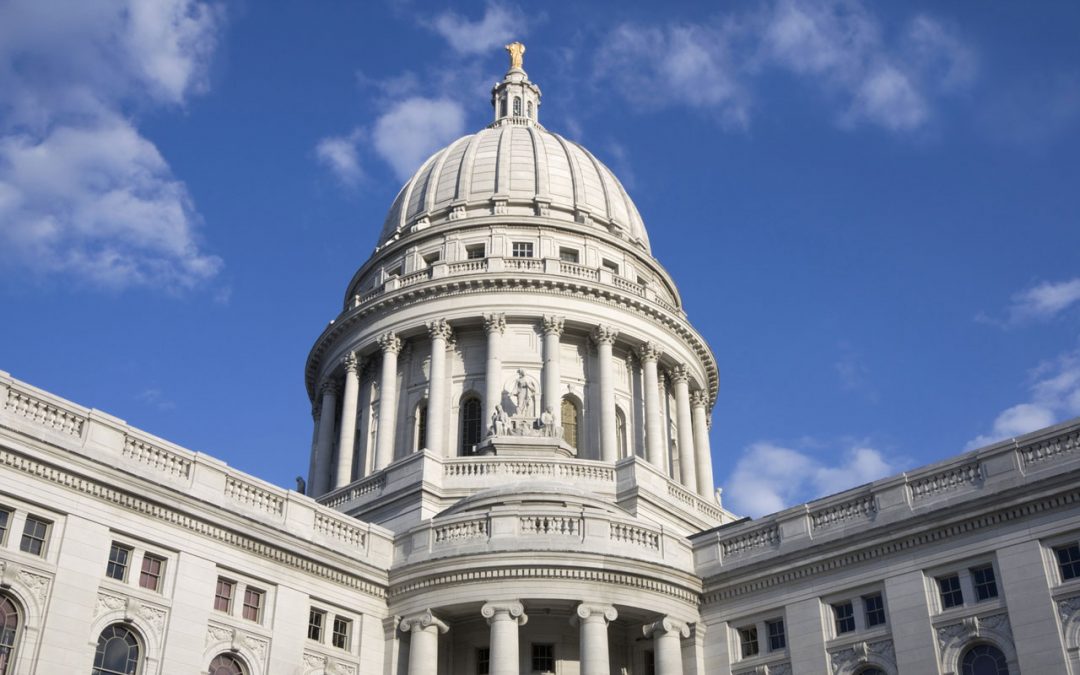
by RENEW Wisconsin | Oct 26, 2021 | Advocacy, Community, Community Solar, Electric Vehicles, Events, Home, Jobs, Legislative Watchlist, Local Government, Policy, RENEW Wisconsin, Renewables, Solar, Sustainability
On October 13, RENEW Wisconsin and Wisconsin Conservative Energy Forum (WCEF) hosted their first-ever Renewable Energy Day at the Capitol in Madison. The event included issue briefings by industry experts on a variety of legislation that has been introduced this year related to the solar and electric vehicle industries. Attendees then went to the State Capitol to speak with their legislators to gain support for these important issues.
During a welcome reception, the evening before the Day at the Capitol, RENEW and WCEF held a panel discussion “Energy in Transition: Policy and Politics.”
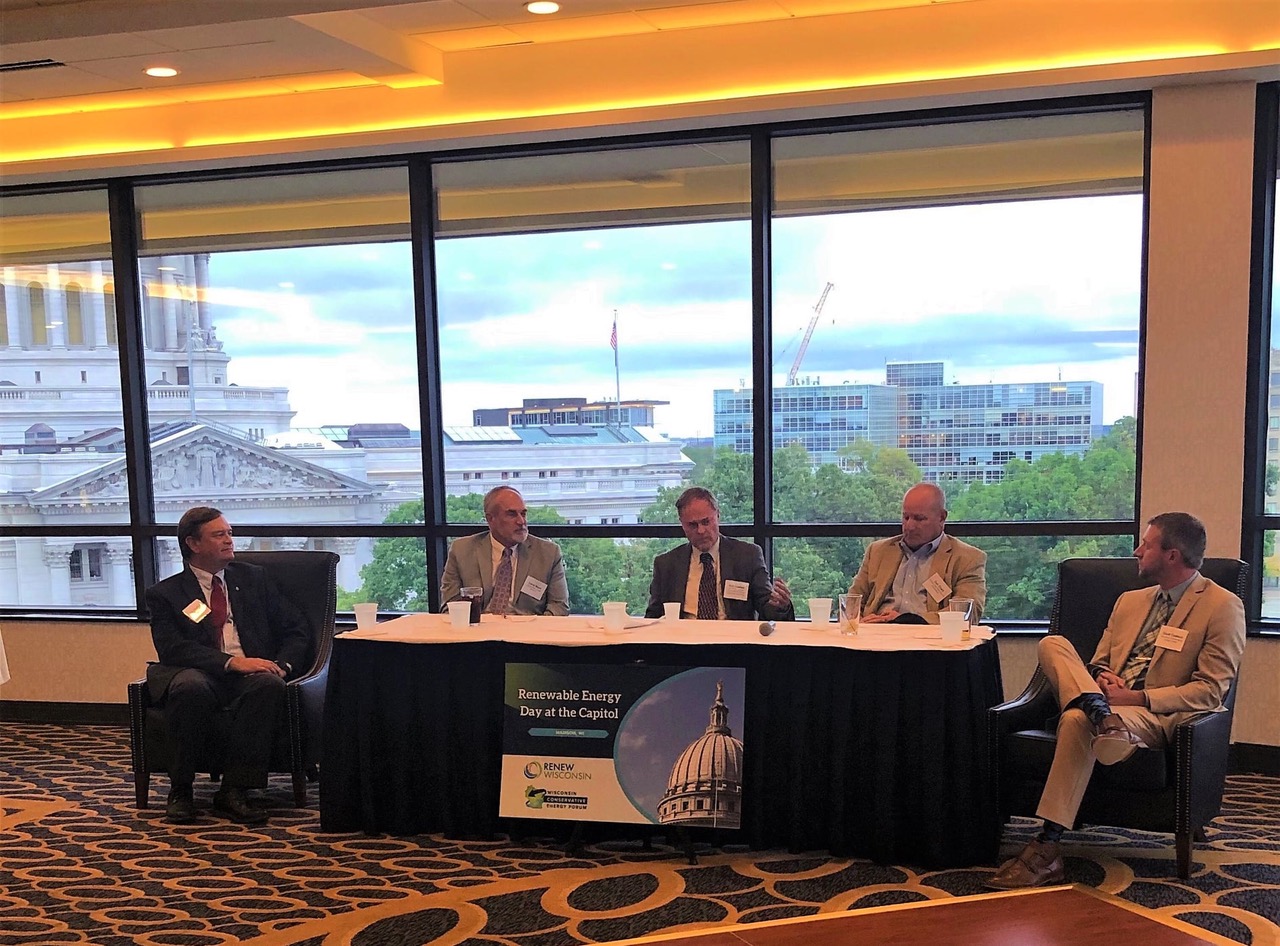
From right to left were moderator, Scott Coenen (WCEF), Dan Ebert (former PSC Chairman), Senator Rob Cowles, Larry Ward (Conservative Energy Network), and Jim Boullion (RENEW Wisconsin).
The panel discussed the current uncertainty in world energy markets and the impact that energy shortages and spiking prices will have on the world. There was consensus from the conversation that panelists believe renewables can help stabilize much of this energy uncertainty, but that the industry needs to be realistic about its role in a world where supply is not meeting demand. Businesses, households, and communities in Wisconsin should be empowered to invest in their own energy generation.
Before attendees went to the Capitol to meet with their legislators, there was an issue briefing with a panel of industry experts moderated by Jim Boullion, Director of Government Affairs for RENEW Wisconsin. The panelists explained in detail what legislative proposals were currently before the legislature, how they will impact renewable energy in Wisconsin, and what arguments are being made on both sides of the issue.
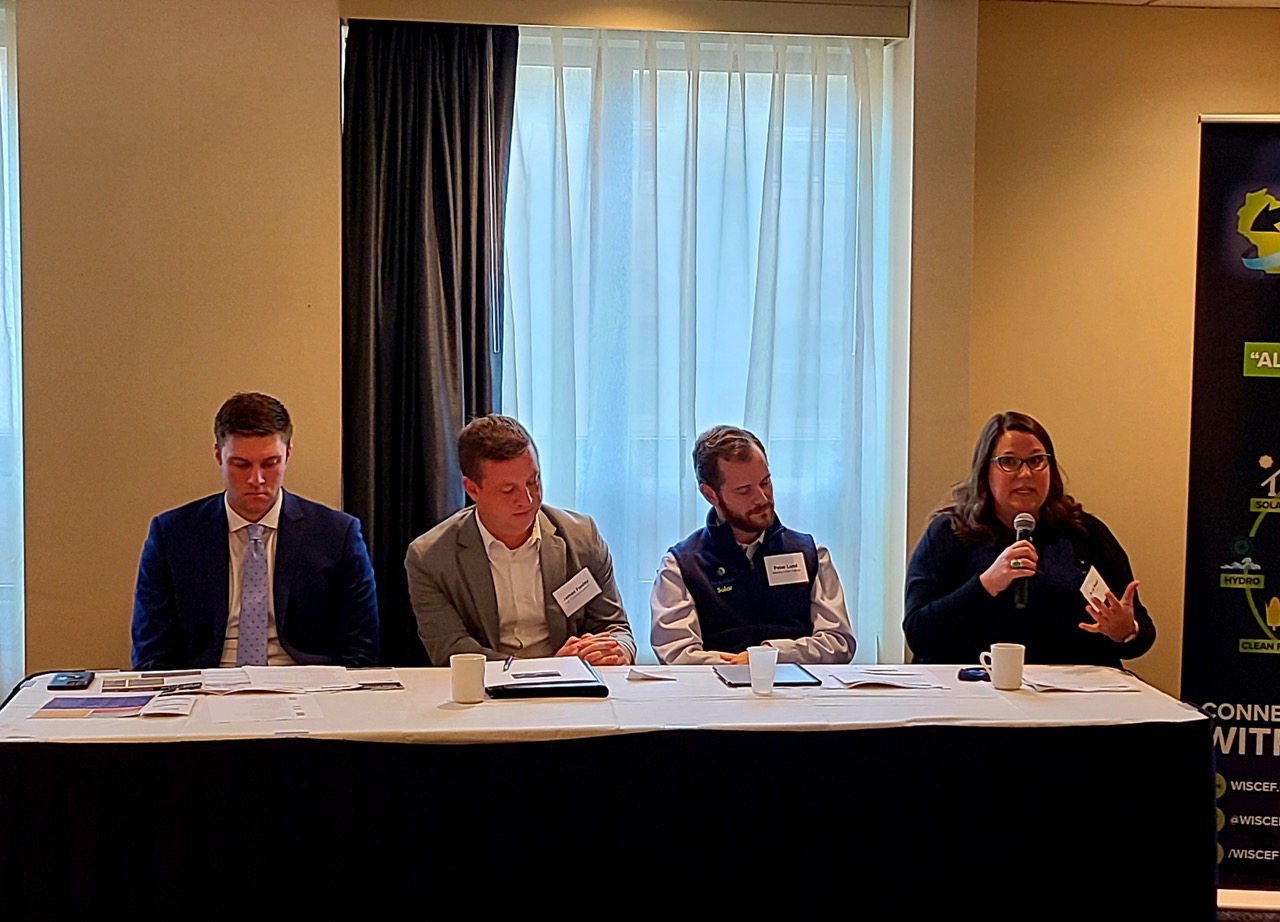
Issue briefing panelists, Left to right: Jason Mugnaini (Chief of Staff, State Senator Rob Cowles), James Fenley (SJL Government Affairs & Communications), Peter Lund (Financial Structuring Associate, Nautilus Solar Energy), and Amy Heart (Senior Director, Public Policy, Sunrun).
The first panel discussed two solar-related issues:
- Expanded Development of Community Solar – (SB 490 / AB 527 – Sen. Stroebel and Rep. Ramthun) This bill would authorize the development of non-utility owned community solar projects and provide access to the economic and environmental benefits of solar for those who can’t afford the full cost of a system, live in multi-family housing, or own property that is not suitable for solar.
- 3rd Party Financing/Leasing – (LRB 1550/1 Sen. Cowles and Rep. Cabral-Guevara) This legislation would clarify that 3rd party financing/leasing of renewable energy equipment is legal in Wisconsin, providing affordable financing options for people, businesses, municipalities, or not-for-profit entities who don’t have the resources to pay for solar on their own property.
The second panel, moderated by RENEW’s Jeremy Orr, Emerging Technology Program Manager, discussed electric vehicle issues such as Wisconsin’s recent Direct Electric Vehicle Sales legislation, SB 462 / AB 439 (Sen. Kooyenga and Rep. Neylon). Albert Gore, Policy and Business Development at Tesla, discussed how allowing manufacturers to sell electric vehicles directly to consumers creates greater access to the electric vehicle market, resulting in growth in the traditional dealership model. Read Jeremy Orr’s previous testimony on this issue here.
Likewise, Justin Ackley, Public Policy Manager at ChargePoint, spoke to the business clarity and consumer transparency that AB 588 / SB 573 (Sen. Cowles and Rep. VanderMeer) would provide, as it would allow non-utility-owned charging stations to charge by the kWh. Similar to a gas pump, where the price per gallon is displayed, kWh charging tells electric owners how much energy they’re paying for, regardless of how long it takes to charge their vehicle. The panel pointed out that while the main goal of this legislation is good, another section of it would create problems by prohibiting charging a fee if any of the electricity going through the EV charger comes from a non-utility source such as a solar+storage system.
Emerging technology allows EV chargers to be installed in areas, especially rural areas, that have inadequate grid infrastructure and can help limit costly spikes in energy “demand charges” for charging station owners. EnTech, a division of Faith Technologies based in Menasha, Wisconsin brought one of their portable solar+storage units to Capitol Square to demonstrate how the technology works and how flexible it can be. A similar system was set up at Bergstrom Ford in Neenah to help reduce the energy bills at their dealership. John Bergstrom, the owner of the dealership, told the story of why he worked with Faith Technologies to install the system in this podcast.
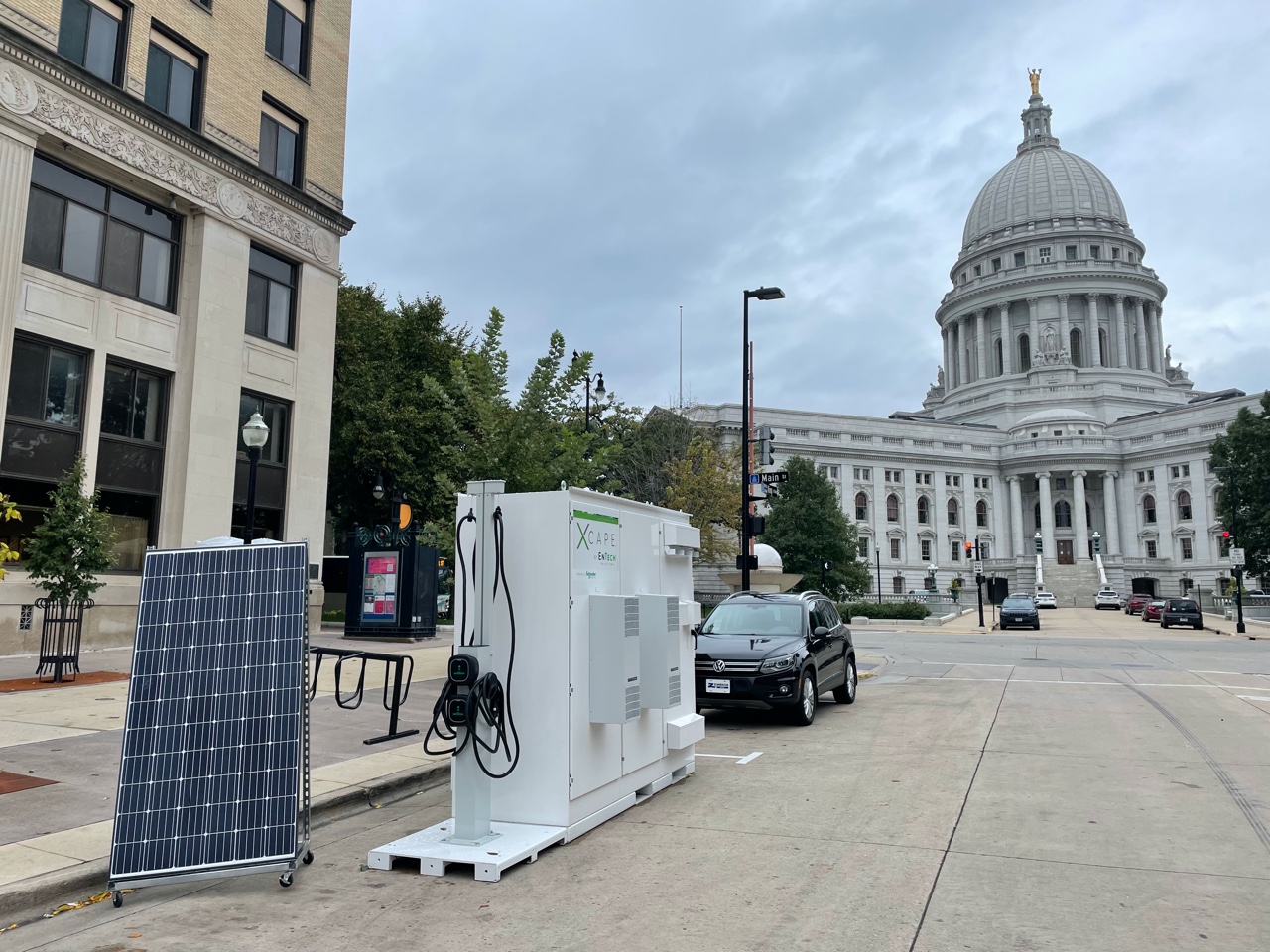
The panel closed the session by discussing two other bills recently introduced by Sen. Rob Cowles:
- $10 million in VW Settlement Funds for EV Charging Station Grants – (LRB-0254/1 Sen. Cowles and Rep. VanderMeer) Grants from these funds would be used to install electric vehicle charging stations at key locations throughout Wisconsin.
- Energy Storage Sales Tax Exemption – (LRB-1513/1) – Sen. Cowles and Rep. Duchow) This legislation would clarify that battery storage devices installed as part of a renewable energy system should be included in the sales tax exemption that already exists for renewable energy system equipment.
The 75 registered attendees made an impact by taking time out of their busy lives and getting involved in the political process. None of these issues will be easy to pass. In fact, most of them face significant opposition from powerful forces. But working together and building coalitions with pro-renewable energy friends helps get important legislation like this adopted.
If you would like to learn what you can do to help as well, contact Jim Boullion, Director of Government Relations at jim@renewwisconsin.org.
by Jeremy Orr | Oct 22, 2021 | Advocacy, Electric Vehicles, Jobs, Renewables
On Thursday, October 21st, the U.S. Department of Commerce Economic Development Administration awarded the State of Wisconsin a $1 million Statewide Economic Development Planning Grant, via the American Rescue Plan, for statewide electric vehicle (EV) adoption initiatives. The grant program is aligned with the Biden Administration’s Build Back Better Agenda to increase U.S. competitiveness and boost the economy.
Wisconsin’s Department of Administration (DOA), in collaboration with the Wisconsin Economic Development Corporation (WEDC) and the Wisconsin Department of Transportation (WisDOT), will administer the grant funds, which will focus on end-user demand, as well as EV charging station planning and EV manufacturing supply chain opportunities.
The funding will also supplement work already underway by the Wisconsin Office of Sustainability and Clean Energy, which is developing a statewide Wisconsin Clean Energy Plan to implement advanced vehicle technologies like electric vehicles to address Wisconsin’s transportation emissions. The Office is also leading efforts on the newly released Regional Electric Vehicle (REV) Midwest MoU, which will focus on medium and heavy-duty transportation electrification across a five-state region in the Upper Midwest, as well as the Lake Michigan Electric Vehicle Circuit, which will create a light-duty electric vehicle corridor around Lake Michigan.
The potential economic growth and job creation from the grant could be substantial. Aside from creating pathways to reduce Wisconsin’s transportation emissions, the $1 million in public funds could spur a five-fold return on investment and job creation, in addition to $2.60 in private investments for every $1 of public investment spent. This means that the $1 million public investment for electric vehicle initiatives has a potential total return of $7.6 million for Wisconsin’s economic growth and job creation.

by Heather Allen | Oct 19, 2021 | Advocacy, Electric Vehicles, Jobs, Renewables, Solar
Thirty-one Wisconsin businesses signed a letter supporting ambitious clean energy investments and broad interest in the American Jobs Plan. The signatories, representing higher education institutions, local governments, and biogas, solar, finance, and electric vehicle industries, are committed to “advancing the clean energy economy, building family-sustaining jobs, and expanding economic opportunities for Wisconsinites.”
The letter states, “Wisconsin’s cumulative solar capacity more than doubled in the past year and is anticipated to quintuple in the next 3-5 years. Wisconsin’s clean energy workforce is 76,000 strong, and solar and advanced transportation jobs proved remarkably resilient even during the economic upheaval of 2020.” Investing in these sectors can create jobs and opportunities for Wisconsin to become a clean energy leader in the Midwest.
The electric vehicle sector is a key focus of the American Jobs Plan and an area where Wisconsin has tremendous opportunity to invest. Recent studies and RENEW’s analysis suggest that the federal stimulus funds spent on transportation electrification will yield a 500% return on investment.
Corry Bullis of U.S. FLO said that “Given President Biden’s goal to deploy 500,000 charging stations by 2030, FLO is expanding its manufacturing footprint to meet increasing demand in the U.S and support its climate and air quality goals. Incentives, as outlined by the American Jobs Plan, will be critical to delivering on this promise. We urge Congress to pass an infrastructure package as soon as possible.”
Wisconsin’s solar job market held steady throughout the pandemic. The industry continues to advance, and local job opportunities are growing rapidly, signaling clean energy investments are a bipartisan solution to growing Wisconsin’s economy and advancing careers for local workers.
Ed Zinthefer, an owner of Arch Electric based in Plymouth, WI, says, “More homeowners and businesses are saving money and supporting local jobs in their neighborhoods by going solar. We are busier than ever, growing and hiring and building more clean energy projects. It’s a great time to get into clean energy in Wisconsin.”
Even as the renewable energy markets are growing, there is an urgent need to drive investment and expand our workforce. According to the Solar Energy Industry Association, the solar industry is on a trajectory to reach 400,000 solar jobs by 2030. However, employment will need to exceed 900,000 workers by 2035 to reach President Biden’s 100% clean electricity goal.
Sign your name to support federal investment in clean jobs here in Wisconsin!
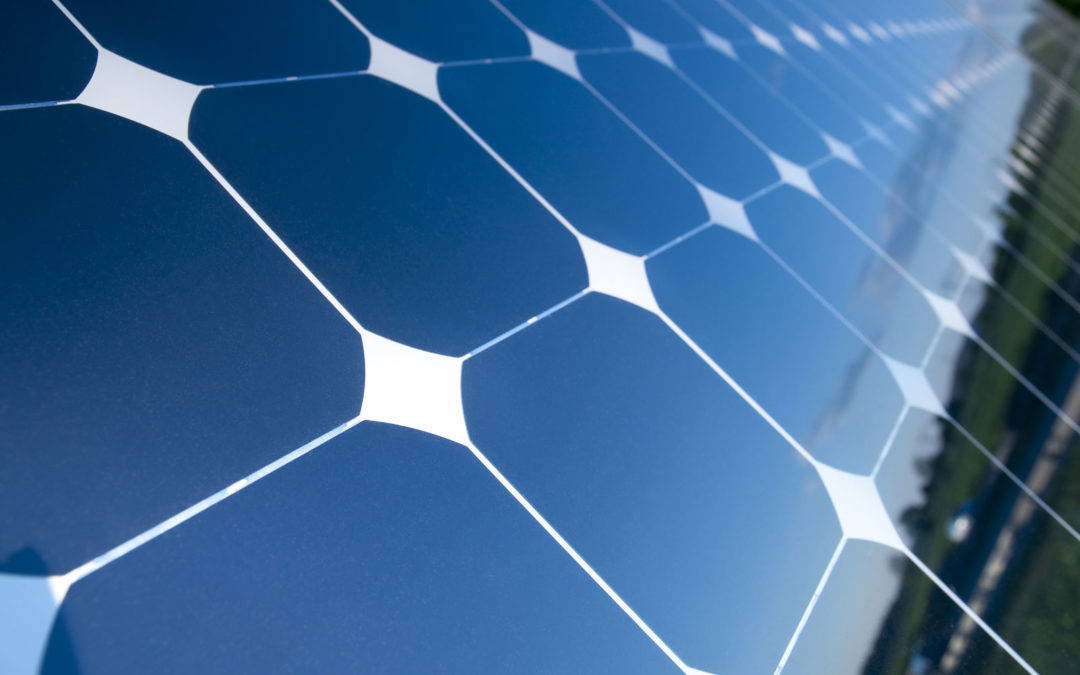
by Jodi Jean Amble | Oct 13, 2021 | Policy, Press Release, Solar, Utilities
Today, Senator Rob Cowles (R – Green Bay) and Representative Rachael Cabral-Guevara (R – Appleton) introduced legislation that would clarify using a lease, sometimes known as third-party financing, to acquire a solar array is legal in Wisconsin. RENEW Wisconsin and the members of the Wisconsin Solar Coalition applaud the introduction of this legislation and urge other legislators to support it.
“This legislation will expand access to solar energy in Wisconsin by allowing businesses and homeowners a basic financing option available in other states. Decades of Wisconsin case law and statutes allow for solar leasing or third-party financing,” said RENEW Wisconsin Executive Director Heather Allen. “However, over the past several years, some utilities have challenged solar installations with third-party financing structures. Since the Public Service Commission of Wisconsin and courts have avoided clarifying the law, it is up to the legislature. Without clarity, Wisconsinites lack access to all of the financing options they need to meet their clean energy goals, create jobs, and manage energy bills while improving the resiliency of the electric grid. Wisconsin must affirm the legality of third-party financing to facilitate the shift to clean energy for everyone.”
Across the country, leasing equipment is one of the most often used financing methods for distributed solar. This legislation is an opportunity to provide greater access to affordable, emission-free electricity for all Wisconsinites. Clarifying this law will positively impact many individuals, businesses, and organizations.
“As a building design consultant serving health care and educational clients, I see a tremendous appetite to utilize third-party financing to develop renewable energy projects, microgrids, and heat and power installations to drive down operational costs and increase resiliency, said Mike Barnett at HGA Architects and Engineers. He added, “Unfortunately, in Wisconsin, there is no legal clarity surrounding third-party financing. If the legislature clarified the legality of third-party financing, these types of capital investment projects and associated jobs would dramatically increase.”
Niels Wolter of Madison Solar Consulting said, “I have many not-for-profit and public (i.e., governmental) clients doing amazing work. They would love to do solar projects but don’t qualify for tax incentives. Third-party financing would be an amazing solution for them to generate solar power, reduce their operating costs and teach their communities about renewables.”
Allen added, “This is a simple question of giving individuals, businesses, and organizations the solar financing options that work best for them.”







 Governor Evers and the Project Developer, Eric Udelhofen, from OneEnergy Renewables at the Ribbon Cutting Ceremony for the Strobus Solar project.
Governor Evers and the Project Developer, Eric Udelhofen, from OneEnergy Renewables at the Ribbon Cutting Ceremony for the Strobus Solar project. O’Brien Solar Fields in the city of Fitchburg, Wisconsin.
O’Brien Solar Fields in the city of Fitchburg, Wisconsin. 




